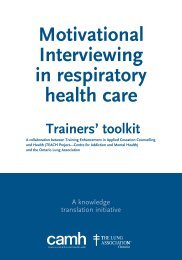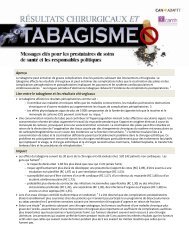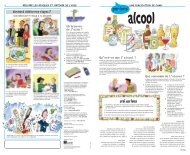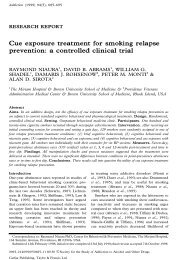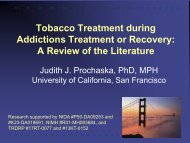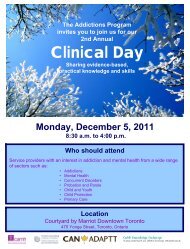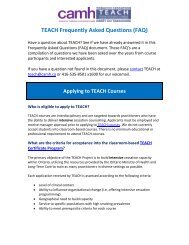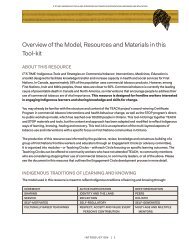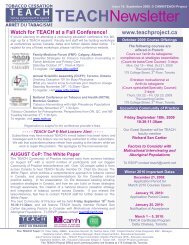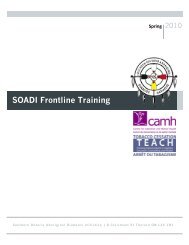Canadian Smoking Cessation Clinical Practice Guideline
Canadian Smoking Cessation Clinical Practice Guideline
Canadian Smoking Cessation Clinical Practice Guideline
You also want an ePaper? Increase the reach of your titles
YUMPU automatically turns print PDFs into web optimized ePapers that Google loves.
CANADIAN SMOKING CESSATION GUIDELINEdeveloping high quality guidelines, as well aswebsites of national and international specialtysocieties. A general internet search was alsoconducted to ensure that no CPGs were missed. Fiveguidelines, which met the basic pre-determinedquality criteria (as above), were found to be publishedafter the initial search in 2006. [Appendix D]REVIEW AND APPRAISAL OF IDENTIFIEDCLINICAL PRACTICE GUIDELINESThe 14 guidelines (combining those from 2006 and2008) identified in both reviews were evaluated byfour independent reviewers using the AGREEInstrument. The reviewers were practicing familyphysicians in Ontario who had each been formallytrained in the application of the AGREE Instrument.In addition to the AGREE Instrument, 8 additionalquestions were included as part of the appraisal. Thisstep, called AGREE Plus was encouraged by the GACin order to better understand the applicability of theguidelines to the <strong>Canadian</strong> context. It has been theexperience of the GAC that the applicability section ofthe AGREE often misses important considerations forthe guidelines’ use once the guideline is put intopractice. The following additional questions wereprovided by the CAN-ADAPTT Coordinating Team.Each reviewer responded to the questions/statementsbelow using a 4-point Likert scale and/or comments,where appropriate.1. The recommendations made in the guideline areappropriate for the intended users (i.e., you andyour colleagues) to perform.2. The recommendations made in the guideline arepractical for the intended users (i.e., you andyour colleagues) to perform.3. The recommendations made in the guideline areconsistent with patient treatment expectations.4. The recommendations are compatible withexisting attitudes and beliefs of the guideline’sintended users (i.e., you and your colleagues).5. The recommendations can be performed by theguideline’s intended users (i.e., you and yourcolleagues) without the acquisition of newcompetencies (knowledge, skills, etc.).6. What new competencies, if any, would berequired?7. Criteria can be extracted from the guideline thatwould permit the measurement of specificoutcomes related to the recommendations.8. Criteria can be extracted from the guideline thatwould permit the measurement of adherence tothe recommendations.CAN-ADAPTT considered only those guidelines thatscored highly in multiple AGREE domains,particularly in the areas of Rigour of Developmentand Editorial Independence, as well as guidelines thatwere ‘strongly recommended’ by reviewers as beingapplicable to the <strong>Canadian</strong> context. The domains ofRigour of Development and Editorial Independenceaddress the majority of the methodological questionsthat help to determine quality of the guidelinedevelopment process. The GAC advised thatguidelines which do not adequately address theseitems should not be considered to be a high qualityclinical practice guideline and should not be includedin the development of CAN-ADAPTT’s guideline.Six guidelines met our criteria and were selected foruse in developing the dynamic CAN-ADAPTT CPG.[Appendix E] This process has been developed andwas recommended by the <strong>Guideline</strong>s AdvisoryCommittee (GAC).CAN-ADAPTT extracted key recommendations fromthe highest scoring guidelines, and used these as theformal evidence base to inform the development of itsguideline.NOTE: CAN-ADAPTT did not review the primaryliterature to inform the development of its SummaryStatements unless emerging evidence was identified by the<strong>Guideline</strong> Development Group.SUMMARY STATEMENTS ANDCLINICAL CONSIDERATIONSDEVELOPMENT AND APPROVAL:A <strong>Practice</strong>-Informed ApproachThe CAN-ADAPTT process of guideline developmentwas informed by the ADAPTE process 8 . Thismethodology was unique in that evidence wasextracted from existing high quality guidelines todevelop summary statements. Evidence tables werecreated for each of the guideline sections (as listed onpage 3). The existing CPGs identified for inclusionwere reviewed and relevant recommendationsextracted for each section along with the level ofevidence/grade of recommendation attributed to it bythe original guideline developer. The CAN-ADAPTTCoordinating Team developed draft summarystatements from the existing recommendations foreach theme and included it in the evidence tables. TheChair of the GDG reviewed the evidence tables andapproved for distribution to the GDG.The entire GDG reviewed the evidence tables andsuggested revisions independently. The CAN-ADAPTT Coordinating Team collated the revisionsMETHODS 5




